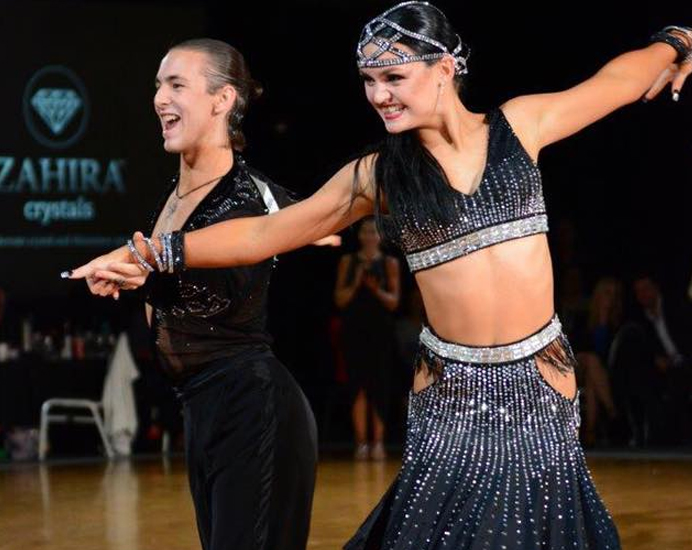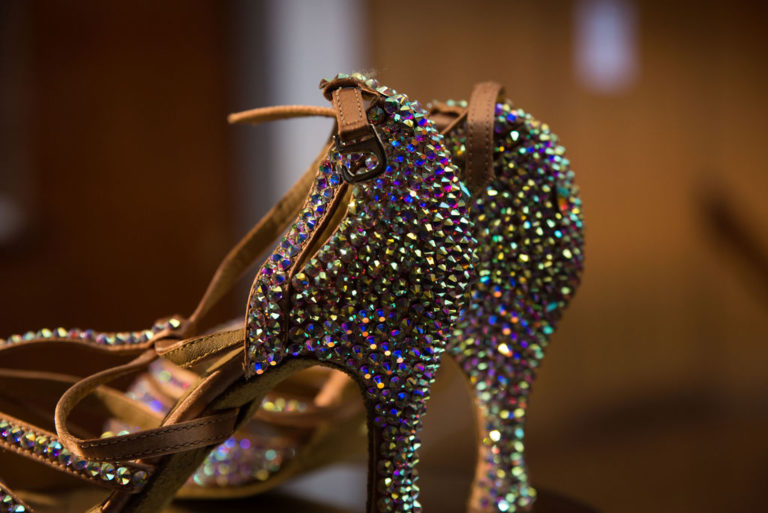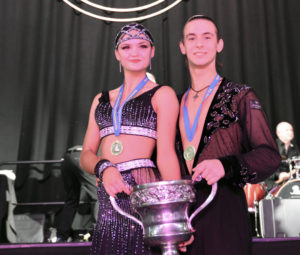Ballroom Dancing Dresses for Competitors - The Ultimate Guide
The right ballroom dancing dress could be the difference between coming first in a competition and not even appearing in the runner up spots. It will make dancing more comfortable and underline body movement than any other regular dress. Moreover, ballroom dancing has a specific dress code particularly if you regularly participate in competitions. While you could get away with a simple dress for practice, you will need a more sophisticated dress design with rhinestones and decorations to improve your chances of winning a competition. We answer the most common questions on what to wear in what competition, differences between Recreational and Dancesport Competitor ballroom dancing dresses, and how to choose your rhinestones for maximum effect. This article is a guide on how to choose and wear ballroom dancing competition dresses that will make you stand out and look more professional.

Best Ballroom Dancing Dress Designs for Competitions
In Australia, Ballroom dancing may be classified into Standard (Ballroom and New Vogue). Anyone who can dance, Jive, Cha Cha, Rhumba, Waltz, or Foxtrot can dance with practically anyone from any part of the world.
Competitors can compete in one of two divisions – as an “Amateur” or “Professional” dancer registered with Dancesport Australia, the governing body for Ballroom Dancing in Australia or as a “Recreational” dancer (not required to register with Dancesport Australia). What the competitor can wear to a competition depends upon whether they are registered with Dancesport or not. Furthermore, dress restrictions are imposed on Registered Dancesport competitors under the age of 13, classified as Registered “Juvenile” competitors.
Dress Styles for Standard, New Vogue and Latin Styles
Recreational Dress: According to Dancesport rules, competitors are required to wear normal “day wear” dresses with no decoration allowed (rhinestones, sequins, pearls etc). In addition to this, rhinestone jewellery, including necklaces and bangles cannot be worn. Competition style dress cannot be worn. According to Dancesport Australia, the focus for these competitors should be on their dance ability, not attire and aims to keep the cost of competing to a minimum.
Juvenile (Under 13 years old) Registered Competitors: Girls are permitted to wear competition style dresses that meet Dancesport regulations. This includes a simple-style competition dress that is one colour (excepting flesh colour) with no embellishments including rhinestones, pearls and beading. Furthermore, accessories including jewellery, belts and gloves are not permitted. Similar to recreational dancers, the focus for competitors in this age division in on dance ability not dress and to keep competition at an “age-appropriate” level.
Junior, Youth, Adult, Masters, Professional and Pro-Am Registered Competitors: Dancers in these divisions have greater choice in what they can wear, so long as they meet the Dancesport dress regulations. Dresses in these divisions tend to have lots of embellishment. For Standard and New Vogue styles, dresses are elegant in design, heavily decorated with rhinestones and pearls and often in New Vogue dances, competitors will wear gloves, floats and rhinestones that make them glamorous and luxurious. They typically have full long skirts that could be in solid or multi colours made in classical styles. Latin dresses are quite unique in style and dancers are quite creative in their design of the costume. The Latin style of dress often appears to have “no limits” and so long as they meet Dancesport rules, dancers can use whatever colours, fabrics or embellishments they desire. There is one common feature of a Latin style dress, however – lots of rhinestone embellishment. Sparkle is the main aim and the greater the number of rhinestones on the gown, the better. Latin dances are generally fast moving and when there are many couples competing on a dance floor with limited time to catch the judges’ eye, dress styles must be bold, bright and extremely sparkly. There is one rule with Latin dresses – you can never have too many rhinestones – the more, the better.
Ballroom Dancing shoes
Your shoes are an important part of your costuming and whilst very important they are professionally fit, providing support and functional, they also improve the look of your whole outfit and presentation. Using good quality rhinestones to design your shoes is essential to show off your dance moves. However, stoning ballroom dance shoes could be very daunting, that is why outsourcing stoning to a specialist not only saves you time and effort but also ensures that your stoning is done at a high-quality standard.

There are many rhinestones on the market from leading rhinestone brands to cheaper, imported stones that can make the endeavour to select the right stone quite overwhelming. However, you can follow these tips to select the best rhinestones for your ballroom dance dress.
1. Colour coordination
Coordinating fabrics and rhinestones can be a tricky task and the rhinestone you choose with depending upon the look you are trying to create. Where a more subtle, understated look is desired it is advisable to select a rhinestone colour closest to the fabric colour. This allows fabric and rhinestone to blend whilst giving off a beautiful, delicate sparkle on the floor. Sometimes a mix of complimenting colours will be used or colours of the same hue, providing an ombre effect. This provides a point of interest in the dress and a great deal of sparkle. Conversely, contrasting colours are often used to give lots of “pop” on the dancefloor. For example, a dress made of navy blue or black fabric may be stoned with Silver or Crystal AB rhinestones providing a striking contrast and loads of sparkle. Don’t be afraid to experiment by mixing sizes and shapes. The variation will provide texture, depth and high lustre.
2. Design
Design requires creativity and imagination to make your ballroom dress stand out and unique. Talking to a stoning consultant that specialises in ballroom dresses helps get you the right stone design for your event or competition. Zahira stoning consultants have many years in design experience under their belts and work with you to bring your dress vision to life.
3. Types of Rhinestones
Rhinestones can either hotfix applied with a hot glue gun, non-hotfix fixed with gemstone glue or larger shapes that are sew-on. Flatback pearls are also non-hotfix and adhere the same way non-hot-fix rhinestones. Zahira non-hotfix rhinestones come with a brushed foil backing that is fixed onto garments or shoes using a gemstone glue. Zahira hotfix rhinestones come with a pre-glued backing which melts and adheres to the fabric under a hot glue gun. All you need to apply your rhinestones is either a quality gemstone glue such as Gem-Tac for the non-hotfix stones or a purpose designed hot glue gun if using hotfix rhinestones.
Sew-on stones can also be glued using gemstone glue, however, due to the weight of the crystal, it is recommended they are also sewed onto the garment for extra hold. Using these fixing methods should provide durability and long-wear.
4. Shine and Rhinestone Colour Reflection
Nearly all colours can work as ballroom dance dresses though you also need to take into consideration the attributes of the wearer. The colour of the rhinestone will be dependent on the colour of the costume. Avoid very pale colours which can easily turn grey or “wash out” under the strong lighting of ballroom dancing floors. You do not want to be seen in grey as it is not a colour that is very flattering and can make you look ashen. Photographs and video will also not be very complimentary to you or your dress. When it comes to rhinestones choose one with many facets such as Zahira, which have 16 sides that will shine and make you stand out on the dance floor.
5. Adhesion
The best quality rhinestones come with a gold or silver brushed foil backing for non-hot fix stones to provide maximum adhesion. Zahira stones use a brushed foil backing in combination with a quality gemstone glue for maximum adhesion. This is unlike some leading providers, who may sell cheaper “DMC” or other cheap imported stones that have been known to fall off during competitions. There are many low-quality stones with a shiny smooth backing that often peel causing the rhinestone to fall off the costume and leave a silver foil stain on the dress.
While leading rhinestone or crystal brands used to produce the best rhinestones in the industry there is no longer much difference between these brands and what we offer. At this point in time, it can be argued the quality and functionality of the different brands of rhinestone is pretty much the same. As such, the most sensible option is to shop based on price, colour, and cut. Like other leading high-end brands, our SS20 and SS16 rhinestone have 16 facets which mean each stone is cut with 16 faces – 8 small triangles and 8 large triangles. This makes them stand out and sparkle on the dance floor as there are more surfaces to catch the light. Check this when selecting your rhinestone. The more facets the rhinestone has, the greater the opportunity for light to refract.
Moreover, Zahira Crystals is a small Australian family business founded by Angela Vlam who has been involved in the Ballroom Dance scene for over 15 years. Her whole family have competed in Dancesport competitions throughout Australia so we can safely say that Angela and her team have a soft spot for dancers. The Zahira Crystals team is committed to helping you get the best ballroom dance dress by offering you a free consultation session on rhinestone dress design. Zahira also offers stoning services for your ballroom dress or outfit at very affordable prices.
For more information about Dance, Dancewear, Dance costumes, & rhinestones and embellishments check out these articles:


